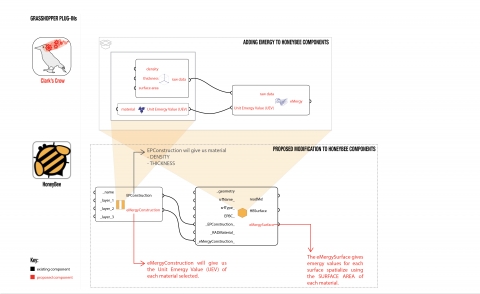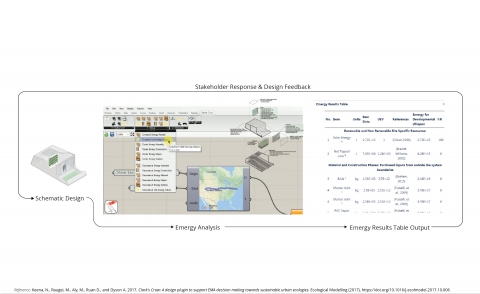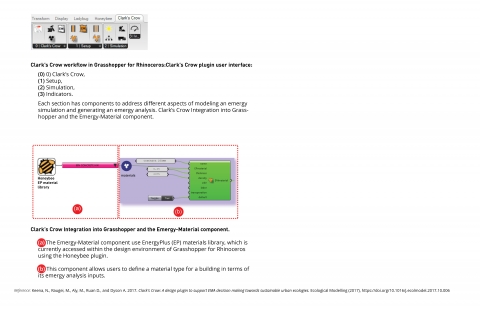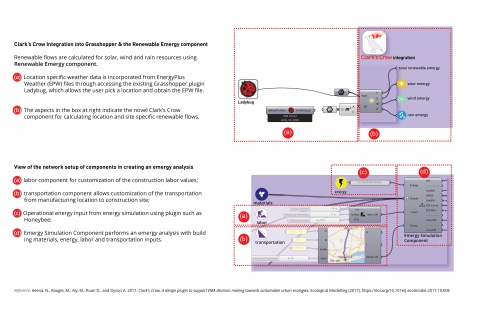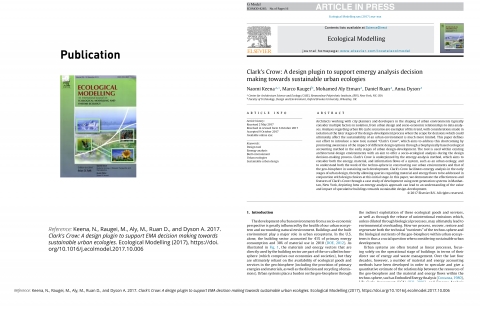
Clark’s Crow aims to promote awareness of the impact of different design options through a biophysically based ecological accounting method in the early stages of urban design-development. The tool is used within existing architectural design environments with an aim to offer a socio-ecological analysis during the design decision-making process. Clark’s Crow is underpinned by the emergy analysis method, which aims to consider all the energy, material, and information flows of a system, such as an urban ecology, and to understand both the work of the techno-sphere in constructing our urban environments and that of the geo-biosphere in sustaining such development. Clark’s Crow facilitates emergy analysis in the early stages of building and urban design, thereby allowing queries regarding material and energy flows to be addressed in conjunction with design choices at this initial stage.
Developed by Naomi Keena, Mohamed Aly, and Δaniel Ruan at the Center for Architecture Science and Ecology (CASE) at Rensselaer Polytechnic Institute (RPI), under the guidance of Professor Anna Dyson. Special acknowledgements to Dr. Marco Raugei for his technical assistance and contributions to this tool, as well as Dr. Nancy Diniz and Dr. Alexandra Rempel's support during the conceptualization of this tool and its development. Further acknowledgements to the Ladybug/Honeybee plugins, which this work leverages.
For further information about Clark's Crow, see our following papers:
Keena, N., Raugei, M., Aly Etman, M., Ruan, D., & Dyson, A. (2018). Clark's Crow: A design plugin to support emergy analysis decision making towards sustainable urban ecologies. Ecological Modelling, 367, 42-57. https://www.sciencedirect.com/science/article/pii/S0304380017302764
Keena, N., Aly Etman, M., Diniz, N., Rempel, A., & Dyson, A. (2016). Towards a visualization framework to evaluate the emergy of built ecologies. Proceedings from Emergy Synthesis 9: Theory and Applications of the Emergy Methodology (pp. 127-142). Gainesville, FL: Center for Environmental Policy, University of Florida.
Aly Etman, M., Keena, N., Diniz, N., Rempel, A., & Dyson, A. (2016). New parametric framework motivating environmentally conscious design. In P. L. Roche, & M. Schiler (Ed.), Proceedings from 32nd International Conference on Passive and Low Energy Architecture. Cities, Buildings, People: Towards Regenerative Environments (pp. 640-645). Los Angeles, CA: PLEA.
Keena, N., Aly Etman, M., Rempel, A., & Dyson, A. (2016). Designing built ecologies: Investigating the potential of emergy analysis to inform the decision making process within architectural systems design. In P. L. Roche, & M. Schiler (Ed.), Proceedings from 32nd International Conference on Passive and Low Energy Architecture. Cities, Buildings, People: Towards Regenerative Environments (pp. 1775-1782). Los Angeles, CA: PLEA.
The current release of Clark's Crow is a beta release, with future updates planned. We'd love to hear your feedback!
----------
Installation instructions:
- Download latest version and make sure the zip file is unblocked (Right click > Properties > Unblock)
- Extract the files to a temporary location
- Move ClarksCrow.gha and Newtonsoft.Json.dll to your Grasshopper components folder
- Restart Rhino/Grasshopper
- When using Clark's Crow, specify a Unit Emergy Value (UEV) database, or use the one provided (Right click main Clark's Crow component > Manage UEVs > Load)
- License Type:





